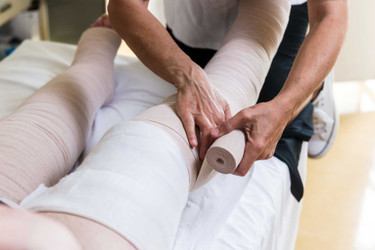Functional Footwear For Orhopedic Devices
Posted by Stephen O'Hare, Pedors Shoes on Dec 15, 2023
Fantastically Functional Footwear For Orthopedic Devices
Fantastically Functional Footwear for accommodating lower extremity orthopedic and therapeutic devices
Updated: March 31st 2021
Shoes that work for compression stockings, bandages, wraps, sleeves, pads, orthotics and bracing.
For more than 20 years, Pedors Shoes has been known as the “go-to” shoe company for forefoot deformities such as bunions, corns, hammertoes, arthritis and diabetes. The proprietary upper material used, called Pedoprene™, allows the forefoot of the shoe to stretch and mold to accommodate deformities and also gives some compression to help reduce edema.
The Pedors Classic was the original stretch orthopedic shoe, an innovative design that incorporates the latest material technologies to provide new orthopedic and therapeutic footwear solutions for the hard to fit foot.
The Top Ten Key Takeaways when fitting shoes and lower extremity orthopedic and therapeutic devices.
- When looking for shoes to accommodate a device, go wider rather than longer.
- When measuring for size, take a tracing with the device in place.
- Evaluate if the shoe can be easily adjusted for fit, velcro closure, additional spacers.
- Consider the weight of the shoe and the person wearing the shoe. The larger the person the more support will be required in the shoe. The lighter the person the lighter the shoe needs to be so gait is not compromised.
- Ensure the shoe is comfortable on the foot when worn with the device. If it’s not, neither the shoe nor the device will be worn and can’t do any good in the closet.
- If fall risk is a concern, evaluate the design features in the shoe to minimize tripping.
- Function over aesthetics. Don’t compromise on functionality because of how a shoe might look. Most orthopedic and therapeutic shoes only become a thing of beauty once they are on the foot and the person is mobile again.
- Comfort = Patient Compliance
- Compliance = Increased Mobility
- Increased Mobility = Quality of life and longevity.
The Need for Extra-Depth and Extra-Wide Footwear
Finding shoes that have enough volume inside the shoe for swelling or to accommodate an orthopedic or therapeutic device is the #1 reason why people end up on Pedors.com. It’s what we specialize in. Over the past several years, we have expanded the product line as demand for even more volume and girth in footwear has increased drastically. The main reason for the demand is the increase in the incidence of phlebologic and lymphologic diseases such as varicosis, thrombophlebitis, phelbothrombosis, chronic venous insufficiency, primary and secondary lymphedema. Also, after vein surgery and sclerotherapy, extra depth and extra-wide-width shoes are needed to accommodate compression wear during recovery.
For many people, finding a retail facility that carries shoes wider than medium or wide widths within driving distance from where they live is very uncommon. Specialized items are now more commonly distributed large website warehouses or bespoke small businesses online.
To compensate for the lack of extra wide footwear that provides the additional girth required in a shoe, the most common mistake is for people to buy shoes in a retail store that are much longer in length in the belief that by doing so, the shoe will become more voluminous in order to provide more accommodation. This results in ill fitting shoes and increases the risk of tripping, fall and injury and can also lead to other issues related to ill-fitting footwear.
Wide Shoes (D/E), Extra Wide Shoes (EE/EEE), Extra Extra Wide shoes (4E/ 5E) and Extra Extra Extra Wide Shoes (6E/7E)
For people wearing a bandage, a wrap, a sleeve, a pad, an
orthotic or even a brace, the key for getting the right fit is to get the right
width in a shoe. Often the width is
determined by how much girth is required which is dictated by the amount of
swelling in the foot - or the amount of additional girth that is required to
accommodate the device being worn or used in the shoe.
Each shoe manufacturer grades the widths of their shoes slightly differently
dependent upon their last measurements and how their footwear is manufactured.
Using the Pedors Sizing Chart we recommend that a tracing be made of the foot with the device that is to be
worn in the shoe on the foot and then use the chart to determine the size of
shoe required for length, width and also the girth. The girth measurement is
taken by measuring the circumference around the arch of the foot. Measurements should be rounded up to the
nearest 1/8th inch.
More on other design features on shoes for swollen feet here
Compression Wear and ShoesPedors Shoes come in five widths ranging from medium width through to triple extra wide width shoes. The wider the width the more girth and volume is in the shoe to allow for bulkier devices. Pedors come with adjustable touch closure straps that can also be adjusted over the course of the day. Pedors uses our own proprietary material called Pedoprene™ in the forefoot which has a four way stretch feature which also provides some compression in addition to the compression provided by the device being worn.
Compression Stockings Compression stockings are medical grade devices designed to move blood flow. There are degrees of gradient compression dependent upon the need. The unit of measurement for compression is called “millimeters of mercury” or “mmHG, which is a measurement of pressure also used in blood pressure. Mild, Medium and Firm compression wear are available over the counter. Pedors recommends the Genext brand of compression stockings and they can be found here. Extra firm 30-40 Hgmm compression stockings are usually prescribed by the doctor managing your condition.
Mild compression stockings provide 8-15 mmHg and provide relief and minimizes tired and aching legs and prevents fatigued legs from long periods of sitting or standing.
Medium compression stockings provide 15-20 mmHg and are worn for the prevention and relief of minor to moderate varicose and spider veins. They also help for minor swelling of feet, ankle and legs. Also worn during pregnancy. This grade of compression stocking can also help prevent deep vein thrombosis (DVT) which can occur during long airplane flights.
Firm compression stockings provide 20-30 mmHg help prevent and relieve moderate to severe varicose and spider veins. This grade of compression stockings is also known to help for moderate to severe edema and lymphedema. Firm compression stockings are also indicated for the management of active ulcers, post-thrombotic syndrome, and orthostatic hypotension where there is a sudden fall in blood pressure when standing up.
Extra Firm (prescription only) compression stockings provide 30-40 mmHg. At this grade of compression a liner may be needed to slide the stocking onto the leg. Used in the treatment of severe edema and lymphedema as well as in post-surgical treatment to prevent the reappearance of varicose and spider veins. Also fitted for OrthostaticHypotension and Postural Hypotension and the management of venous ulcers and post-thrombotic syndrome (PTS).
Toe Caps For people experiencing swelling in the toes the Haddenham Microfine Toe Cap provides 20-36 mmHg compression and is an effective device that helps improve the fit of a shoe where there might not be much extra depth or width in the toe box of the shoe - in a dress shoe for example. The Toe Cap is easy to measure, easy to fit and ambidextrous and manufactured with fine seams combined with ultra-thin and smooth microfine material. Some customers tell us that when they wear the Toe Cap in conjunction with compression stockings it prevents fluid from being adversely sent down to the toes.
Short Stretch BandagesShort stretch bandages made from 100% cotton are washable and reusable and are designed specifically for the management of venous insufficiency, acute and chronic lymphedema and edema. Unlike long stretch bandages, short stretch is used for strong compression with a high working pressure and low resting pressure to actively support muscle pump work. Rosidal K and Comprilan are the two brands of short stretch bandages that are mentioned by our customers the most.
Ankle Foot WrapsAnkle wraps are bulkier than compression stockings and short stretch bandages but are often preferred because they are quick and easy to put on and require minimal adjustments to maintain compression levels. By extension, this requires more room in a shoe to accommodate the wrap. The Pedors Classic MAX is the “go-to” shoe for people wearing compression wraps.
The bulkier the wrap the wider the width needed. There are a number of manufacturer’s that have different designs, we hear most about Juzo, Farrow Medical and CircAid. The CircAid Juxta Lite uses Breathe-O-Preneⓡ a material similar to Pedoprene that has a limited stretch material that hugs the limb and comes with an anti-odor SILVERtecⓣ and takes less room in the shoe than the Juxta-Fitⓣ and theJuxta-Lockⓣ. Dependent upon what features are needed in a compression wrap, the appropriate width in the Classic MAX can be ordered to accommodate it in the shoe.
Orthotics and InsertsOrthopedic footwear come with extra depth and usually with a removable insole. When using either a prefabricated accommodative insert or a functional orthotic it’s important to remember to take out the insole that comes with the shoe to make room for the device you plan to use. All Pedors footwear have extra depth and come with removable insoles and spacers that range from 3/16th’sof an inch to 9/16th’sof an inch thick. Full length spacers are used to address leg length difference when a device is worn on one side and not the other. This is important as a difference as little as 1/8th of an inch can cause the hips to be out of alignment and can lead to lower back pain.
Bracing
When wearing a brace, an ankle-foot orthosis (AFO) or a foot gauntlet additional room in a shoe is required to accommodate the device. The Pedors Stretch Walker is often preferred by Orthotic and Prosthetic professionals as it is available in Wide, Extra Wide and Extra Extra Wide widths to allow for plenty of room in the heel cup of the shoe. The Stretch Walker (item # 800) also offers plenty of depth (9/16th of an inch) and comes with two additional spacers to adjust the fit of the shoe. Designed to look like a regular sneaker the Stretch Walker is relatively light-weight and has two-velcro straps to make it easy to open the shoe up to place the device into the shoe. Once the fit of the shoe has been determined, some people leave the device in the shoe overnight and slide into both the device and the shoe the next morning. As described above, when trying to determine the correct shoe size to order, it’s a good idea to measure the foot while wearing the device for an accurate measurement of length, width and girth.

